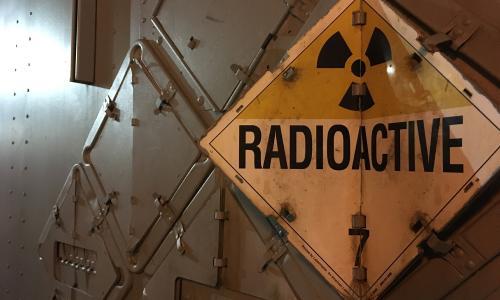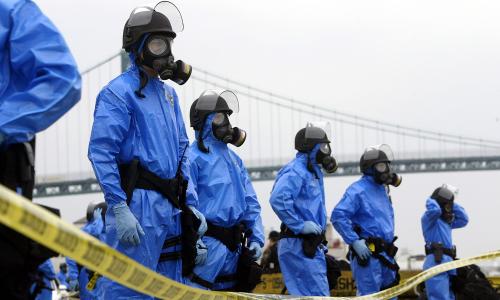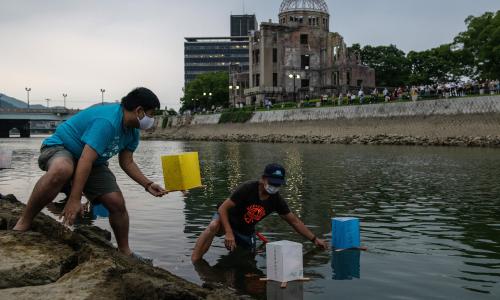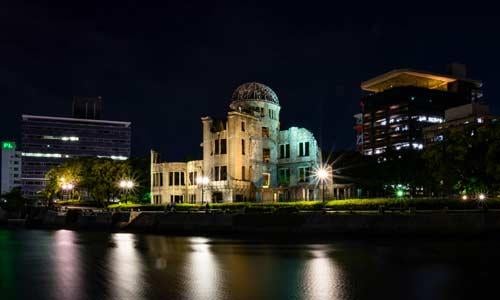This glossary is intended to help advocates navigate the technical language of nuclear weapons and, specifically, radiation and human health outcomes.
| Keyword | Definition |
|---|---|
| ABSORPTION PATHWAY | The mechanism by which hazardous materials within the environment enter the human body |
| ABSORPTION, DISTRIBUTION, METABOLISM, AND EXCRETION | The path that radioactive materials take within the human body and which tissues are most likely to be harmed |
| ACUTE EXPOSURE | Typically occurs at one point in time, with moderate to high contamination levels. For example, in the Hiroshima and Nagasaki atomic bombings, many hibakusha—or bomb-affected people—were left reeling with radiation sickness, cancers, autoimmune disease, and other chronic illnesses from experiencing a large, sudden dose of radiation in their environment. |
| ACUTE RADIATION SYNDROME | Occurs after a high, often sudden exposure, when the radiation can penetrate to internal organs and all or most of the body is exposed. This is also commonly referred to as “radiation sickness.” Symptoms include nausea, vomiting, headache, and diarrhea within hours after exposure, and may cause death in the following days or weeks. The dose range for radiation sickness is 70 rads or 0.7 Gy, and mild symptoms may be observed at doses as low as 0.3 Gy or 30 rads. |
| AQUIFER | An underground area of rock, sediment, or gravel saturated with groundwater that collects from rain or snow. Water in aquifers is naturally filtered from movement through small pores and spaces in the rock. An aquifer's water is discharged either naturally at springs, wetlands, or human-made wells. However, aquifers beneath nuclear milling, mining, processing, and storage sites are often contaminated with radioactive materials not removed by the natural filtration process and cannot be used as drinking water. |
| ATOMIC ENERGY COMMISSION (AEC) | Operated from 1946 to 1974. It was responsible for managing the use and development of atomic/nuclear energy for military and civilian purposes. Part of the Atomic Energy Commission’s responsibilities was ensuring public health and safety. However, many of the labs and production sites where employees were exposed to dangerous materials that caused health problems were performing work for the agency. The Atomic Energy Commission was shut down and its responsibilities were shifted to the new Nuclear Regulatory Commission following strong public opposition. |
| CANCER CLUSTER | Per the CDC, a greater than expected number (based on previously observed or modeled general population statistics) of the same or etiologically related cancer cases that occur within a group of people in a geographic area over a defined period of time. Etiology refers to causes and risk factors associated with the development of disease. For example, exposure to the sun can cause skin cancer. |
| CENTERS FOR DISEASE CONTROL AND PREVENTION (CDC) | The nation's leading science-based, data-driven service organization that protects the public's health. The CDC puts science into action to help children stay healthy so they can grow and learn; to help families, businesses, and communities fight disease and stay strong; and to protect the public's health. |
| CHRONIC EXPOSURE | Defined as occurring or repeating over a long period of time. A low dose is often assumed because high doses are likely to result in death and are not epidemiologically trackable over longer time periods. |
| CUTANEOUS RADIATION INJURY | A skin burn that can occur at radiation doses as low as 2 Gy or 200 rads2 , increasing in severity as the dose increases. At the site of a nuclear detonation, humans are incinerated; further away they will experience severe burns and instant damage to internal organs. Even for people not close enough to be burned (1,500 meters away), their internal organs will receive a large dose of gamma rays and neutrons, causing long-term harm. |
| DEPARTMENT OF ENERGY (DOE) | The department within the US government that manages the country’s nuclear weapons programs and nuclear reactors. The department was created in 1977 and combined the United States’ nuclear weapons development programs and activities with other energy-related programs. The department’s work on the development of nuclear weapons resulted in contamination and the spread of radiation that it is also responsible for cleaning up. |
| DERMAL ABSORPTION | Exposure that involves direct skin contact with radioactive materials, or when radioactive particles enter an open wound |
| DOSE RECONSTRUCTION | According to the CDC, radiation dose reconstruction is a process used to determine past releases of radiological materials, the dose or amount of radiation received by persons in the vicinity, and the possible health effects of the radioactive substances on those persons. |
| EFFECTIVE DOSE | This dosage estimation accounts for the type of radiation, which affects absorption, as does the sensitivity of the organ absorbing the radiation. This is used to set protective radiation exposure limits and is measured in sieverts or rem. |
| ENERGY EMPLOYEES OCCUPATIONAL ILLNESS COMPENSATION PROGRAM ACT (EEOICPA) | A program that provides compensation or medical benefits to workers or their families who experienced illness from exposure to hazardous materials while performing work for the Department of Energy. |
| (ENVIRONMENTAL) TOXICANT | Hazardous materials placed in the environment by human (anthropogenic) sources, including radioactive materials |
| (ENVIRONMENTAL) TOXIN | Any hazardous material in the environment that the human body encounters |
| ENVIRONMENTAL WASTE MIXTURES | Environmental toxicants are often released in combination with other hazardous materials either prior to being released or due to interactions with coexisting environmental hazards. For example, mixed nuclear waste requires special disposal methods and only certain waste facilities accept mixed waste generated by Department of Energy activities. |
| EPIDEMIOLOGY | The study of disease across a population of people |
| EXCESSIVE RELATIVE RISK | When comparing similar populations that differ by exposure category (exposed versus unexposed), researchers consider an increased observation of the outcome of interest; excess relative risk is the relative risk minus one (see RELATIVE RISK) |
| EXPOSURE PATHWAY | The mechanism by which hazardous materials enter the environment. There are many exposure pathways that people can come in contact with—whether at their workplace, in their neighborhood, or by being near a nuclear facility whose safety measures have failed, causing a release of radioactive material. |
| EXTERNAL RADIATION EXPOSURE | Radiation near or around the human body that can enter the body and usually does not include further radioactive decay within the body since the compound is not ingested |
| FETUS | The developing infant during the gestational period; offspring during the gestational period |
| HAZARD | Any category of materials that may alter normal bodily function, such as biological, chemical, physical, or radiological hazardous materials |
| INCIDENCE | New cases or diagnoses of a health condition across a population |
| INGESTION ABSORPTION | The active consumption of radioisotopes through contaminated food or water. Some children also consume dirt that could be contaminated due to unique hand-to-mouth practices early in life. |
| INHALATION ABSORPTION | Occurs when particles and radioisotopes enter the lungs through breathing and subsequently make their way into the bloodstream |
| INTERNALIZED RADIATION EXPOSURE | Radioactive materials that enter the body during decay and likely create decay products while in the human body |
| INTERNATIONAL COMMISSION ON RADIATION PROTERCTION (ICRP) | An independent, international organization that advances for the public benefit the science of radiological protection, in particular by providing recommendations and guidance on all aspects of protection against ionizing radiation; a charity (not-for-profit organization) registered with the Charity Commission for England and Wales (registration number 1166304); and a community of about 350 globally recognized experts in radiological protection science, policy, and practice from around 40 countries |
| MORBIDITY | Any departure, subjective or objective, from a state of physiological or psychological well-being. These are often referred to as disorders or diseases, and co-morbidity is two or more disorders that a person lives with. |
| MORTALITY RATE | According to the CDC, a measure of the frequency of occurrence of death in a defined population during a specified interval of time |
| NATIONAL CANCER INSITIUTE (NCI) | The federal government's principal agency for cancer research and training |
| NATIONAL PRIORITIES LIST (NPL) | The National Priorities List lists sites throughout the United States threatened by hazardous substances, pollutants, or contaminants. The list functions as a guide for the Environmental Protection Agency on what sites require further investigation or cleanup. |
| NUCLEAR FRONTLINE COMMUNITY | The myriad communities near nuclear testing sites, nuclear materials mining and processing sites, nuclear waste storage facilities, and other nuclear sites. |
| NUCLEAR JUSTICE | An abstract concept supported by concrete actions to ensure communities know they have a right to their own history, their health issues are taken seriously, and any environmental harms are recognized. It also looks to ensure communities have an opportunity to take part in the democratic process of making global policy. For example, voices of women and BIPOC (Black, Indigenous, and other people of color) and rural communities are vastly underrepresented in these decisionmaking circles, and constituents’ views are often left out of the discussion. The only path to true human security begins with fundamental changes to the way nuclear weapons decisions are made—and ends with the abolition of nuclear weapons as one piece of creating an equitable world. |
| NUCLEAR SITE | A reactor or nonreactor nuclear facility where an activity is conducted for or on behalf of the Department of Energy and includes any related area, structure, building, or activity to the extent necessary to ensure proper implementation of the requirements of 10 CFR Part 830 |
| NUCLEAR OR RADIATION TREATMENT | This type of therapy uses doses of ionizing radiation to target cancers and mechanisms of certain autoimmune disorders. Although it can cause a weakened immune system, the benefits of targeting deadly or debilitating disease outweigh the risks of exposure or not treating. |
| ODDS | The probability of an outcome happening. This is normally compared to a coin flip (flipping the coin is always a 50% probability of heads or tails), but in health we often think of the odds of being exposed, unexposed, a health outcome positive, or a health outcome negative (see ODDS RATIO). |
| ODDS RATIO | A measure of association that quantifies the relationship between an exposure and health outcome from a comparative study; also known as the cross-product ratio. These comparisons are often made across four categories: exposed, unexposed, health outcome positive, and health outcome negative. |
| PREVALENCE | Existing cases or diagnoses of a health condition across a population |
| RELATIVE RISK | According to the National Cancer Institute, relative risk is a measure of the risk of a certain event happening in one group compared to the risk of the same event happening in another group. In cancer research, relative risk is used in prospective (forward-looking) studies, such as cohort studies and clinical trials. A relative risk of one means there is no difference between two groups in terms of their risk of cancer, based on whether or not they were exposed to a certain substance or factor, or how they responded to two treatments being compared. A relative risk greater than one or less than one usually means that being exposed to a certain substance or factor either increases (relative risk greater than one) or decreases (relative risk less than one) the risk of cancer, or that the treatments being compared do not have the same effects. Also called risk ratio. |
| REPRODUCTIVE JUSTICE | The human right for all gender minorities to have control over their sexuality, gender, work, and reproduction. That right can only be achieved when all women, girls, transgender, two-spirit, and gender-nonconforming people have the complete economic, social, and political power and resources to make healthy decisions about their bodies, families, and communities in all areas of life. |
| SOCIAL DETERMINANTS OF HEALTH | Society-created categories of people based on where they are born, live, learn, work, play, worship, and age that affect a wide range of health, functioning, and quality-of-life outcomes and risks. These factors (including gender, race, ethnicity, age, socioeconomic status) can each—and in combination—compound the harms of radiation exposure. For example, due to systemic oppression including xenophobia, racism, and ageism, specific identity groups may lack access to quality health care or living assistance, healthy and affordable food, and education around preventative medicine. |
| SUBMERSION | Involves part or an entire limb, or an entire person, being submerged in radioisotopes. Lab workers use glove boxes to protect their health while assembling the plutonium pits that go into nuclear weapons, but when the gloves are torn or compromised, it can cause a limb to become partially or completely submerged in plutonium. |
| SUPERFUND SITE | Any region or facility currently or formerly contaminated with hazardous materials and eligible for cleanup under the Comprehensive Environmental Response, Compensation and Liability Act (CERCLA). CERCLA/Superfund refers to a trust fund established by Congress in 1980 to manage the cleanup of emergency and hazardous waste sites that would require long-term cleanup. CERCLA forces the parties involved in creating the contamination or hazardous site to perform cleanup activities or reimburse the government for the cost of cleanup. In the event there is not a responsible party, the Environmental Protection Agency (EPA) is given the funding and authority to conduct cleanup activities. States or concerned citizens are often the ones to report concerning sites to the EPA, which then assesses the site to determine the level of risk it poses to human health and to establish a cleanup plan. In 2023, EPA records indicated 1,881 Superfund sites across the United States (see www.epa.gov/superfund/what-superfund). |
Related explainers
Explainer

Understanding Radiation
Radioactive materials are elements that spontaneously break apart, or “decay,” into lighter elements over time. Radiation is energy that’s released during that process—and it’s can be dangerous.
Explainer

How Radiation Interacts with the Human Body
Radiation is absorbed by humans in many ways, and can harm the human body in the short and long term.
Explainer

Where Radiation Comes From
Human-made sources of radiation have increased since the 1940s in the environments people live in and near.
Explainer

Health Impacts of Radiation Exposure
Radiation is associated with a wide range of adverse health outcomes, including acute radiation sickness, burns, cancer, cardiovascular disease, or even death.
Activist Resource

An Activist's Guide to Radiation and Human Health
Essential readings for understanding the world of radiation, radioactive materials, and the threats they pose to human health
The Union of Concerned Scientists has worked on nuclear weapons-related issues for more than 50 years. Get involved here.


